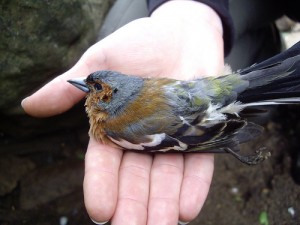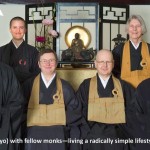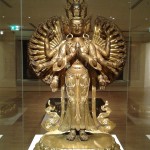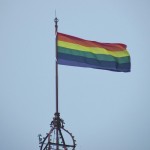 From a very early age I sensed there was something wrong. I remember being around ten years old, cradling the tiny body of a dead bird. It was so small it fit easily in the cup of my child-sized hands. The bird had died after hitting our cabin window, and although I was horrified by its fate and my part in it, however indirect, I also relished the opportunity to view the bird so closely. It was an iridescent yellow-green color, and its feathers looked looked like fine hairs. The coloring over the bird’s whole body varied in subtle ways that enhanced its beauty, as if someone had carefully painted it and adjusted the shading for hours before deciding it was just right. The bird was like a jewel, all the more amazing because it had been a living, moving being.
From a very early age I sensed there was something wrong. I remember being around ten years old, cradling the tiny body of a dead bird. It was so small it fit easily in the cup of my child-sized hands. The bird had died after hitting our cabin window, and although I was horrified by its fate and my part in it, however indirect, I also relished the opportunity to view the bird so closely. It was an iridescent yellow-green color, and its feathers looked looked like fine hairs. The coloring over the bird’s whole body varied in subtle ways that enhanced its beauty, as if someone had carefully painted it and adjusted the shading for hours before deciding it was just right. The bird was like a jewel, all the more amazing because it had been a living, moving being.
My mind struggled to resolve the cognitive dissonance created by two opposing realities. On the one hand life was indescribably amazing and beautiful. There seemed no end to subjects and objects of pure wonder – animals, ecosystems, oceans, caves, planets, kidneys, hands, atoms, genes… I felt the kind of awe for the natural world that some feel for God, and for that world I felt gratitude and devotion. Then there was wonder of human love, as manifested by my family and by inspiring, beneficent people throughout time. This love led people to express themselves in writing, art, and music that at times was able to directly evoke in me such depth of feeling, tears of joy would flow out of my eyes uncontrollably.
But then, on the other hand, I felt responsible for the destruction of life just through the act of living. The way I saw it, unless I renounced all participation in – and all the benefits of – human society, I was culpable for all the extinctions, environmental degradation, injustice, poverty, and oppression that humans were causing.
This wasn’t just a matter of realizing that things had to die so I could eat, or that flowers don’t last forever. Impermanence and the cycle of life and death were part of that indescribably amazing and beautiful life. What I could not accept was the pointless destruction based on greed, hatred, fear, and ignorance.
It made matters worse that I didn’t know how much of earth’s resources I deserved, and that I loved life so deeply I never believed my existence and pleasure justified destruction of any kind. There was no escape from this dilemma: Even in my cabin in the woods, simply enjoying nature and spending time with my family, our picture window lurked as a death trap for little birds.
I felt like a bull in a china shop, causing harm wherever I went. Of course, I didn’t see myself as being unique among human beings in this regard. We were all bulls in a china shop as far as I could tell, knocking this indescribably beautiful and amazing life out of whack all the time. It is not overstating the matter that I thought human beings were a scourge on the earth, and that the best thing we could do to preserve life was to stop breeding. I thought this at the same time as I loved individual humans and had awe for the depth of love and generosity they were capable of. It was possible to hold both views at the same time, although not comfortable, and probably not very healthy.
If you grew up when I did, in the 1970’s and 80’s, you may understand exactly the view of the world I am describing here. If you don’t, or if it sounds extreme, remember that we grew up living each day with the thought that nuclear missiles could appear out of nowhere at any time and obliterate absolutely everything we knew. Everything and everyone. It wasn’t just that a bunch of people would be tragically killed in a war but then we would rebuild. Everyone and everything we knew and loved would be destroyed, to be replaced by a radioactive wasteland.
We grew up watching incredible nature programs on television that got us up close and personal with the most amazing forms of life on our planet, and every single one of them ended with a warning about how whatever we were just introduced to was under the threat of extinction or destruction. We grew up surrounded by images of suffering and injustice from all over the globe: starvation, war, racism, persecution, corruption, greed, the list goes on. The good things people did were noble and inspiring, but they were often in response to the bad things and barely seemed to mitigate them.
Many years ago I wrote a poem about this strange experience of growing up:
Growing up Conflicted
They said there were enough bombs
to destroy the whole planet, but
I had only just discovered
kangaroos. My dad held me perfectly
in a bear hug so I knew I was beautiful
and capable of anything, but
the girl who threatened me in the school bathroom
didn’t think so. My childhood was warm
and smelled of my mother’s homemade bread, but
in National Geographic
the kids had stomachs the size of
basketballs.
Unable to decide whether to fight or flee
this world,
whether to take a bite of it
and let its juices stream down, or
cut out the tongue
that might betray me with its lust
and leave me bound and obligated,
I carried a fierce motto around everywhere,
clenched in my fists.
At last, I’m exhausted.
We still demand justice –
the kangaroos, the little kids, and me –
but I still have a tongue
and my desire.
My peers who didn’t succumb to despair seemed to be to be taking the route of pragmatism. “Despair doesn’t help,” they said. “We might as well get on with living and hope for the best.” I respected this choice, although it seemed to me to require a fair amount of denial.
The most significant thing, to me, was that no one had any answers – no reasons for hope. It looked like there were two options: Just get on with living and hope for the best, or take some radical path like Gandhi or Mother Teresa, stepping outside of society and devoting my life entirely to change. As much as I admired and obsessed over the latter, I couldn’t see any path opening up in front of me that looked as if it would make much of a difference. So I opted for the former, but halfheartedly.
—
After 20 years of Zen practice, things no longer look so simple. It’s not that you’re either part of society or outside it. It’s possible to make the pragmatic choice without closing your mind and heart. There are many ways to engage life that don’t require participation in its unnecessary destruction. Waiting to devote yourself to a cause because you insist your sacrifice and effort get maximum bang for their buck is partly egoistic.
Still, I find I have not yet fully resolved the cognitive dissonance between my love for life and my participation in its destruction. It helps to recall the anguish of my younger days – the anguish that still resides somewhere, deep in my heart – in order to motivate myself in the quest to honor my love as fully as I possibly can. If I could be sure that my death would mean the permanent survival of wild polar bears, I wouldn’t hesitate to offer my life. But that kind of hypothetical scenario does not resemble reality in any way. Things just don’t work like that. Instead, I get to wrestle with myriad confusing and ambiguous details, and make choices without being able to predict their full impact.
At least at this point I’m not offering any answers to resolve this cognitive dissonance, even for myself. I’m confident there is a way of resolution – or at least a way to embrace the dissonance with completely sincerity and authentic love – but I’m still working on it. Anyway, each of us has to live our own answers – not because we’re all unique and have different opinions on stuff like airplane travel and genetically modified organisms, but because the answers are not abstract. The answers are deeply personally and must be directly experienced.
Simply calling the conflict to mind and heart seems important. If we don’t allow the question to rest in our consciousness, the answers will be unlikely to arise in response.












